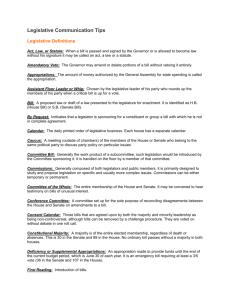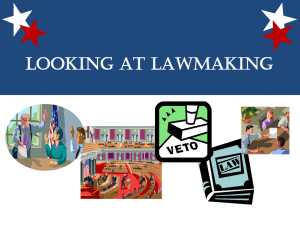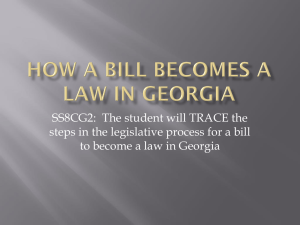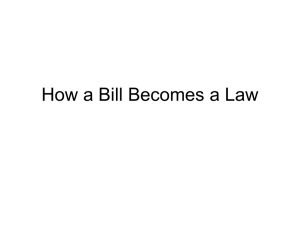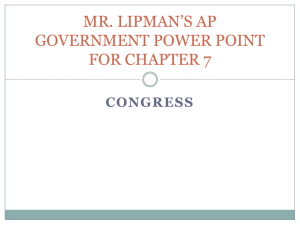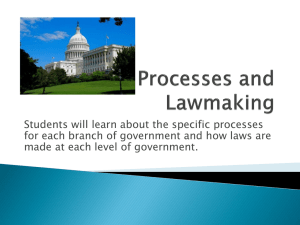Looking at Lawmaking
advertisement
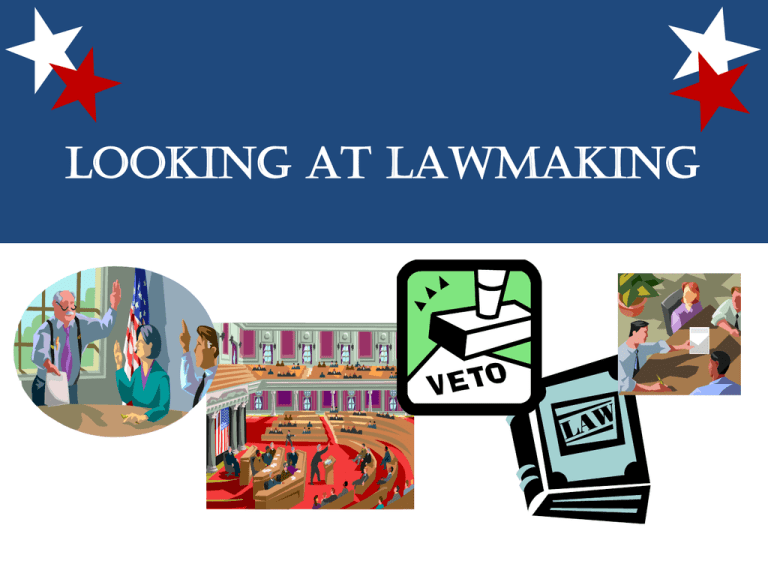
LOOKING AT LAWMAKING Click the pic for the Federalism Facts of Congress! Levels of Government In our federal system of government, powers are shared between three levels: Government Federal State Local Branches of Government Each level of government has three branches – legislative, executive, and judicial. These branches all have different powers, responsibilities, and requirements. Executive Branch Judicial Branch Legislative Branch Federal State Local What does the legislative branch do? Who serves in the Legislative Branch? Congressmen/Congresswomen U.S. Representative U.S. Senator Florida Legislator Florida Representative Florida Senator Commissioner Councilman/Councilwoman Legislative Branch Makes the law What does the executive branch do? Who serves in the executive branch? President Vice President Cabinet Members Governor Lieutenant Governor Cabinet Members Mayor Executive Branch Enforces the law What does the judicial branch do? Who serves in the judicial branch? Justices of the United States Supreme Court Appellate Judges Trial Judges Justices of the Florida Supreme Court Appellate Judges Trial Judges On your worksheet, you will need to correctly identify each branch of government, the role of the branch, and the titles/offices of government officials for each level of government. For the judicial branch, you will need to identify the levels/types of courts. Who Does What? Who Does What? Branch of Government Legislative Executive Judicial Role of this branch Make law Enforce law Interpret and apply the law Federal • Congressman/ Congresswoman • U.S. Senator • President • Vice President • U.S. Supreme Court • U.S. Circuit Courts of Appeal • U.S. District Courts • Florida Senator • Florida Representative • Governor • Lieutenant Governor • Florida Supreme Court • District Courts of Appeal • Councilman/ Councilwoman • County/City Commissioner • Mayor • Circuit Court • County Court • State Local U.S. Representative LOOKING AT LAWMAKING How are laws made in the legislature? The Hierarchy of Law United States Constitution If there is a conflict between a lower law and a higher one, the higher one “prevails”. Acts of Congress Florida Constitution State Statutes (laws) City and County Ordinances The U.S. Constitution is the “Supreme Law of the Land.” Where does it come from? • Where does Congress get the power to make acts/laws? • Where does the Florida legislature get the power to make laws (statutes) for the state? • Where does the local government get the power to make ordinances? Click the pic to see a Fact of Congress on how a bill becomes a law! The cost of living is so high! Because of the downturn in the economy, we only make minimum wage and can barely make ends meet. We need to increase the minimum wage! A bill is an idea that comes from a citizen, group, Congressperson, or the Executive Branch. The bill is sponsored by an interested member of the House or Senate where it receives support from other Congressmen/Congresswomen. This bill is going to start in the U.S. House of Representatives. A bill is officially introduced when it is placed in the hopper on the side of the Clerk’s desk. The title of the bill is entered in the House journal and printed in the Congressional record. The Clerk then assigns the bill a number and it is assigned to the appropriate committee. Here, experts will testify on the bill and then the committee members will make changes or updates based on this testimony. Committee members then vote on whether or not the bill should go to the House floor for a vote. Only 1 out of every 4 bills make it out of committee! Today, that is going to be your job! Some of you are going to be the experts providing testimony on both sides of the bill proposing an increase in the federal minimum wage. Some will testify before the House and some before the Senate. Others will be the committee members for the House and Senate. You will be responsible for asking the experts questions to get enough information so you can make a decision on this bill. If the bill passes committee, it is reported to the House floor for debate. Here, amendments are proposed during the bill reading. When debate is over, the bill is voted on using one of three methods: 1. Voice vote 2. Division a. Members stand to be counted 3. Recorded a. This is the most common way to vote. Members select “yea”, “nay”, or “present” or complete a paper ballot. Why would a member vote “present”? If the bill passes the House with a simple majority (218 of 435), it is sent to the Senate. It is reviewed and discussed in a Senate committee before it is voted on. Senate Committee members and experts for the Senate, it is your turn to testify! If the bill passes committee, it is sent to the Senate for debate and to make amendments to the bill. Unlike the House, Senate members typically vote by voice. A simple majority (51 out of 100) passes the bill. NAY! YEA! YEA! NAY! YEA! YEA! NAY! If the bill passes the Senate, it is sent back to the House with a note about any changes (amendments). If there are amendments: • It may be sent to committee for research • It will be voted on again This process continues until both houses of Congress agree on an IDENTICAL bill. The identical bill is then sent to the President. LAW Once it is here, the President has three options: Sign the bill into law Veto the bill ? M. President Not sign the bill If Congress is in session and it is not signed with 10 days, the bill becomes law. If Congress recesses before the 10 days have passed, the bill dies. If Congress disagrees with the President’s veto, they can override the veto with two-thirds vote in both Chambers of Congress. 2/3 HOW DOES A BILL BECOME A LAW IN FLORIDA? Let’s look at the process… IDEA DECISION BILL DRAFTED 1ST READING From citizen, group or legislator The legislator decides if the idea should be a bill. Bill written by staff and assigned a number.. Published in Chamber Journal. 3RD READING 2ND READING Same process as original Chamber. Final reading of the bill. The bill is voted on and may die if it does not receive a favorable vote. Bill is read on floor of Chamber and may be placed on Special Order Calendar by vote. COMMITTEE ASSIGNMENT /MEETING Return to Original Chamber GOVERNOR CONSIDERATION GOVERNOR FINAL ACTIONS Final versions of the bill must be identical in both Chambers. Governor can sign the bill into law, allow the bill to become law without signing, or veto the bill. If the Governor vetoes the bill, the Legislature may override his/her veto by a 2/3 vote. . Consideration by Opposite Chamber Bill is reviewed, voted on, and can be placed on calendar or allowed to die in committee. LAW If the Governor does not veto the bill, the bill becomes law. In summary, this is how a law is made: IDEA From citizen, group or legislator . GOVERNOR CONSIDERATION Governor can sign the bill into law, allow the bill to become law without signing, or veto the bill. BILL DRAFTED Bill written by staff and assigned a number. COMMITTEE ASSIGNMENT /MEETING Consideration by Opposite Chamber Bill is reviewed, voted on, and can be placed on calendar or allowed to die in committee. Same process as original Chamber. GOVERNOR FINAL ACTIONS If the Governor vetoes the bill, the Legislature may override his/her veto by a 2/3 vote. LAW If the Governor does not veto the bill, the bill becomes law. Check For Understanding What are some important words to look for in this question? Which answers can we eliminate?
